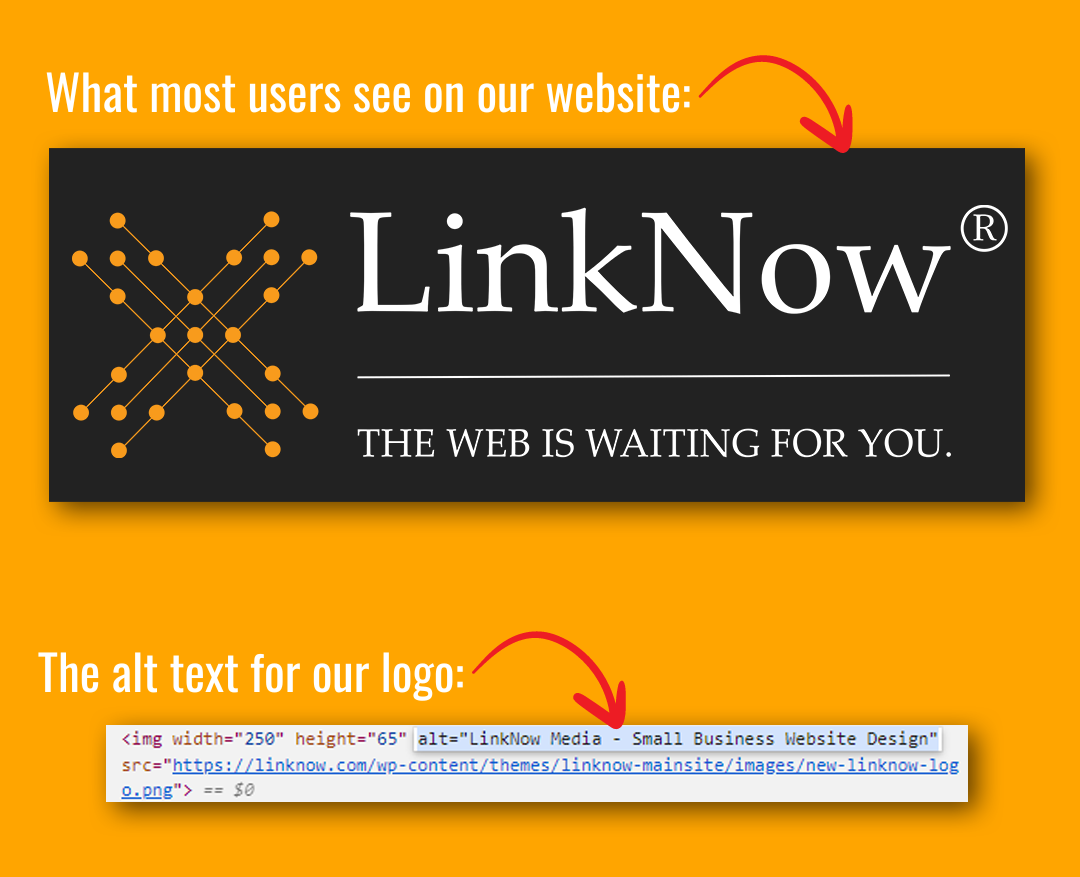
Contents
Optimizing for All: The Intersection of Digital Accessibility and SEO
- What is Web Accessibility?
- Why Does Digital Accessibility Matter Anyway?
- How Accessibility Features Connect to SEO
- How LinkNow Embraces Accessibility
- LinkNow’s ADA Compliance Addon
Optimizing for All: The Intersection of Digital Accessibility and SEO
If you’re a business with a digital presence, reaching the highest number of users with your content is a top priority.
Whether you’re a local contractor, a landscaper, or an attorney, driving traffic to your website requires optimizing your searchability through a range of complex processes. Improving your ranking on Google is one thing, but retaining users on your website and creating engaging content is another.
An often under-appreciated approach to search engine optimization (SEO) involves increasing the accessibility of websites for users with disabilities. While SEO and web accessibility may seem like two distinct concepts, in reality, upholding principles of digital accessibility can contribute to your ranking in search engine results pages (SERPs).
In this blog, we’ll discuss the intersection of digital accessibility and SEO and highlight some strategies we use at LinkNow to reach a wider audience and include more users.
What Is Web Accessibility?
Before exploring the connections between accessible design features and SEO, it’s important to clarify what we mean by web accessibility.
Web—or digital— accessibility refers to the design and creation of websites, online tools, and other virtual products in a manner that accommodates users across the ability spectrum. This can include people with audio, visual, cognitive, or physical impairments and is closely related to the field of user experience (UX).
According to the Web Content Accessibility Guidelines (WCAG), the definitive source for online accessibility design information, there are four fundamental principles that lead to usable web content:
- Perceivable: Any content or user interface on your website must be perceivable by anyone. This means information cannot be invisible to all senses, which can involve solutions like using alt-text or captions to assist users of all sensory abilities.
- Operable: All users should be able to use and operate the features of your website directly. Your web pages should be keyboard navigable, and the interface should be visible and not require interactions a user cannot perform.
- Understandable: Any data or information on your website must be understandable. So, it’s crucial to clearly state where links take you and avoid using obscure acronyms and abbreviations. This principle also includes designing your web content to operate predictably.
- Robust: Web content must be robust enough that assistive technologies, such as text-to-speech readers, can coherently interpret it. Even as technologies and user agents evolve, the content should remain accessible.
Why Does Digital Accessibility Matter Anyway?
First and foremost, making your digital content accessible to users with a wide range of abilities and needs is a clear step toward inclusivity and creating a more just future for all.
A website that is compliant with the Americans with Disabilities Act (ADA) demonstrates that your business is committed to accessibility. Additionally, ADA compliance is mandatory for commercial websites, so you risk litigation and fines if your website is not satisfactory.
If you’re new to website design and content creation, digital accessibility may seem like a secondary concern. However, accessible content is often more streamlined and understandable for users, which can significantly contribute to user engagement and SEO.
Compliance with the WCAG can also improve the overall experience for all users of your website. When you prioritize digital accessibility and inclusive design, you improve your content and help facilitate a seamless online experience.
How Accessibility Features Connect to SEO
Search engines like Google always try to provide the best possible user experience. Technical factors like indexability, crawlability, and local citations impact your SERP ranking, but numerous variables can boost your website’s searchability.
In fact, there is a surprising overlap between features of accessible web design and features of good SEO. Making your web content more accessible doesn’t impede your SEO—it can actually enhance it.
Clear, Understandable Content Ranks
One of the foundational principles of the WCAG is understandability. Users with visual, cognitive, or physical impairments benefit from clear, easily navigable content when browsing a website.
In the world of SEO, unambiguous, authoritative, and relevant content also ranks well. Using strategic keywords, organizational headings, and direct language can make your content easier to grasp and potentially rank higher.
Digital Accessibility Improves Overall User Experience (UX)
One of the most significant reasons to optimize your content for web accessibility is because it will improve your website’s UX. Digital accessibility doesn’t mean compromising original designs and layouts; it’s a way of making your content more straightforward to use and grasp.
Accessible web content allows more users to engage with it and can invite potential customers and partners to explore your pages fully. This can result in increased click-through rates and encourage your users to spend more time on your website, both of which can positively impact SEO.
Voice Search Optimization
A new trend emerging among search engine users is an increase in voice searches. Around 50% of American consumers reported using voice search regularly or daily, meaning brands that optimize their content for voice searching may be able to reach more customers than ever.
Although voice search was not created as an accessibility tool, it has been praised by disabled users and is frequently used by people with physical, visual, and cognitive impairments. Adapting your web page to be findable through voice search can help you reach a wider audience and make your content more accessible.
However, the rules for optimizing your content for voice search differ from traditional searches. Some effective strategies for reaching users relying on voice searching include:
- •Using long-tail keywords/phrases
- •Increasing conversational keywords and content
- •Expanding your FAQs section and question queries
- •Creating more user-specific content
- •Optimizing for local searches
- •Optimizing your web page for mobile use
- •Improving page speed
Voice searching may change the future of SEO, and adapting your content to accommodate more users can assist with your marketing strategy while simultaneously improving your website’s accessibility.
Image Captioning and Alt Text Is a Win-Win
Another common feature of web accessibility is the inclusion of image captioning and alt text for images and video content. Alt text also provides search engines with additional content and context for your images.
Including descriptive alt text can help your search engine better index your images and contribute to the page’s relevance. It also makes your page content accessible to users with disabilities. It’s a win-win.
Enhanced Digital Accessibility Can Drive Traffic to Your Site
Improving your website’s accessibility through design, understandable content, and making it findable through voice searching can also drive traffic to your site. The more accessible your content is, the more users will be able to interact with it and explore your website in its entirety.
Enhanced UX typically provides returns on click-through rate and dwell time, and embracing web accessibility is just one small way you can improve the experience of users and draw more attention to your brand.
How LinkNow Embraces Accessibility
Here at LinkNow, we always look to go above and beyond for our clients and provide users with a seamless, inclusive experience. We’ve been creating mobile-friendly websites for over a decade and have adapted to the challenges of search engines with professionalism and success.
On all our websites, we incorporate balanced design principles and alt text to make them navigable by visually impaired people, improve our UX, and provide our clients with one-of-a-kind hubs for their brands and specialties. We embrace accessibility through the following:
- •Alt-text and captions for images and video content.
- •Responsive design that works on a range of devices.
- •Clear, consistent page layouts to help users navigate our content with ease.
- •Creating labeled form elements, pop-ups, and messages.
- •Avoiding seizure-inducing visual content on our websites.
- •Ensuring there is sufficient contrast between text and background colors.
We’re always looking to embrace new directions for inclusive business practices and corporate responsibility. We’d love to hear from you if you have ideas for making your company’s website more inclusive.
LinkNow’s ADA Compliance Addon
If you want to embrace web accessibility on your current or future website, LinkNow is proud to provide special features that keep your pages accessible and compliant with the Americans with Disabilities Act. We’ve partnered with AudioEye to make your content more accessible and help all users benefit from increased UX and navigability.
We can help you create and maintain a website that is accessible, visually appealing, and optimized for search engine success. You can learn more about our ADA Compliance Addon here or get in touch with us at 1.888.667.7186 to connect with one of our digital marketing specialists.


